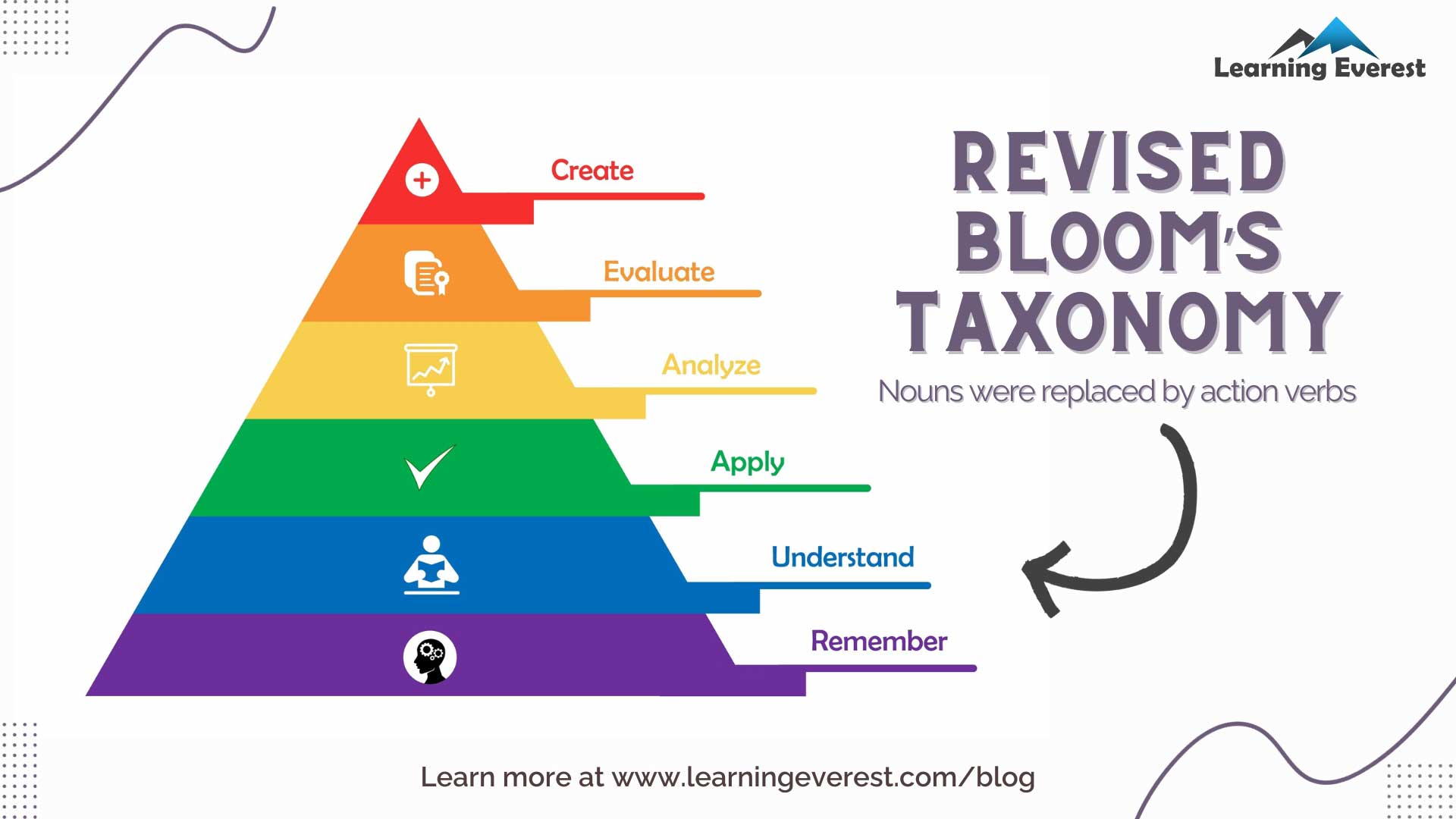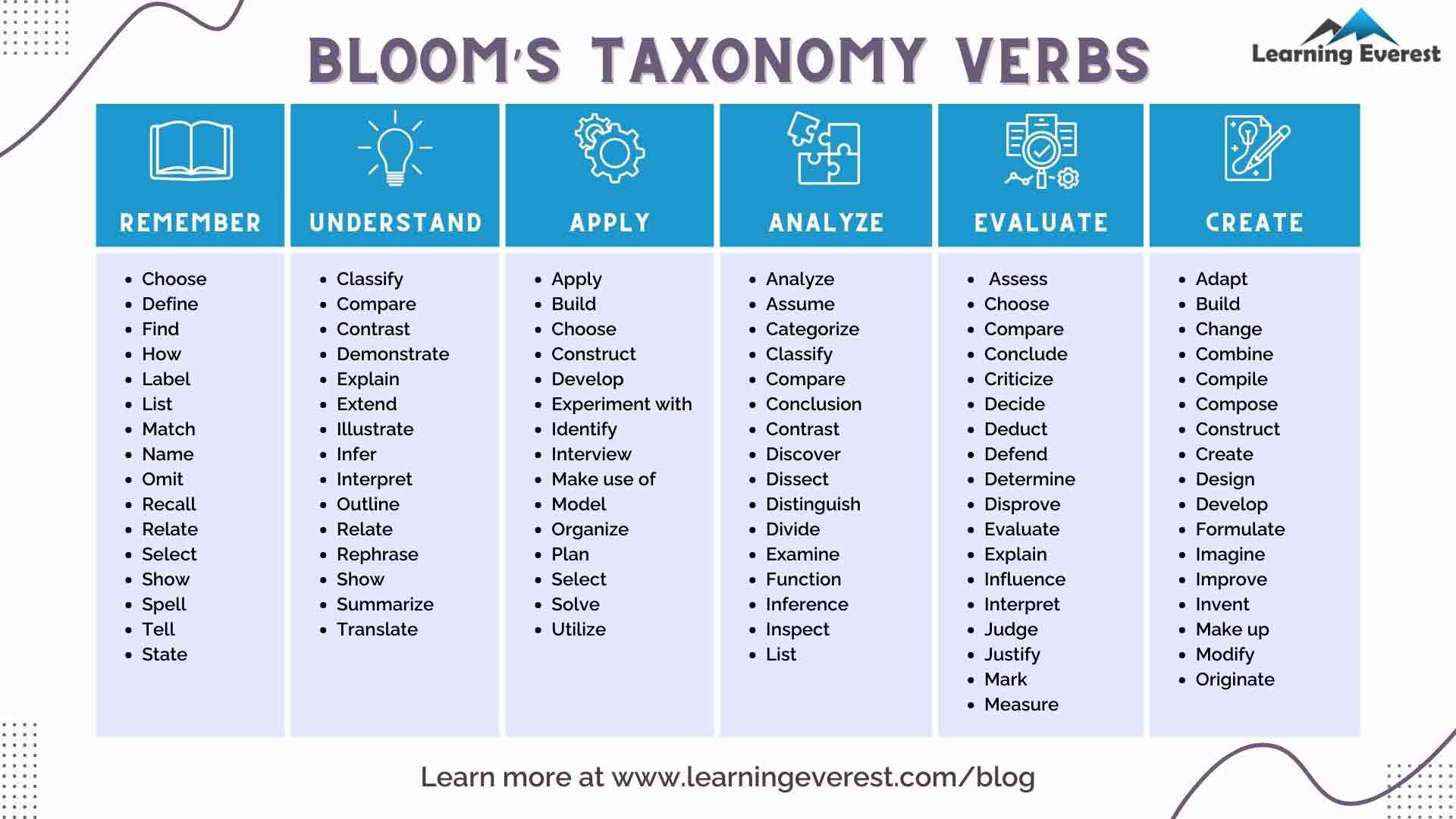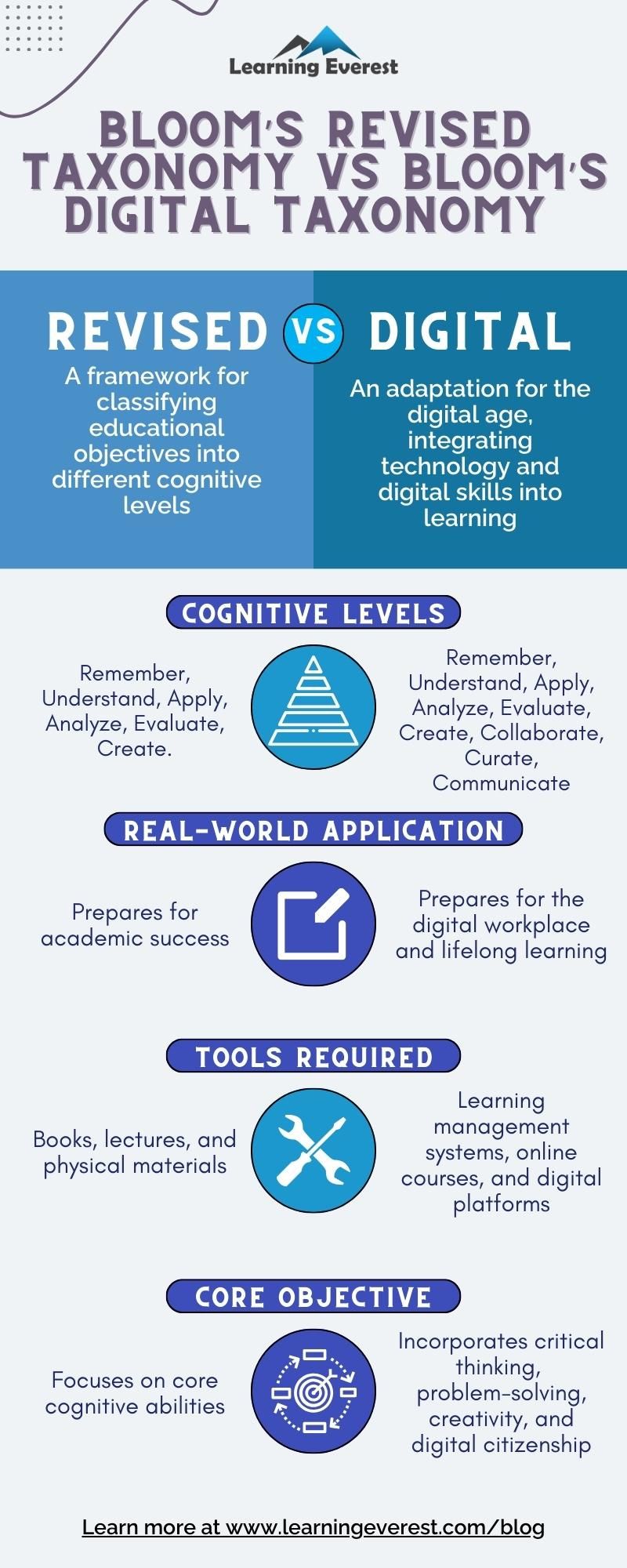Bloom’s Taxonomy was created in the 1950s. With a group of psychologists, Benjamin Bloom created Bloom’s Taxonomy, a hierarchical model of the cognitive skills involved in learning. It set the learning objectives for learners and included six levels, namely Knowledge, Comprehension, Application, Analysis, Synthesis, and Evaluation.
Table of Contents
- What is Bloom’s Taxonomy?
- What is Bloom’s Revised Taxonomy?
- Why is Bloom’s Taxonomy used?
- What are the ways of applying Bloom’s Taxonomy in eLearning?
- Bloom’s Digital Taxonomy
- Infographic
- Knowledge Check!
- Frequently Asked Questions (FAQs)
- What is Bloom’s Taxonomy and how is it defined?
- How has Bloom’s Taxonomy been utilized in course design?
- What is Bloom’s digital taxonomy and how is it related to technology?
- What are the benefits of the Bloom’s taxonomy for the learners?
- Are there distinctive features to Bloom’s than the Original Taxonomy?
- How does Bloom’s Taxonomy improve the training ROI of organizations?
- Will Bloom’s Taxonomy be applicable to self-directed eLearning modules?
What is Bloom’s Taxonomy?
The taxonomy served to help researchers and educators understand how people acquire new knowledge and understanding. Bloom’s taxonomy learning objectives were as follows:
- Knowledge: This includes recognizing or recalling basic knowledge like the terms, facts, or trends without really understanding what they mean.
- Comprehension: This is where facts and ideas are organized and summarized using the main ideas. This is where concepts are differentiated and interpreted by differentiating them from others.
- Application: This includes applying the knowledge gained to solve problems. This involves using the acquired knowledge and applying it in current circumstances.
- Analysis: Information is broken down into parts and then examined to reveal aid new understanding. Learners study each part and understand their relation to one another.
- Synthesis: This includes looking at the pieces as a whole. The information is pieced together, and the learner’s understanding plays an essential role in making sense of the knowledge gained.
- Evaluation: Value judgments are made about the content based on the criteria.
What is Bloom’s Revised Taxonomy?
This taxonomy was revised in 2001 by Lorin Anderson, David Krathwohl, and others. The researchers felt the need to include the new understanding that researching was bringing into the field of learning, and thus, the revised taxonomy was born. This revised version included the use of verbs for the nouns in each level. The new levels are Remembering, Understanding, Applying, Analyzing, Evaluating, and Creating. This new taxonomy is made in a way that goes from basic to complex.

Bloom’s Revised Taxonomy
Why is Bloom’s Taxonomy used?
In creating a course, the learner must be informed of how behavior would change after completing the course. These behavior changes can be successfully conveyed through the learning objectives that are written by using action verbs. When used in defining learning objectives, Bloom’s taxonomy helps the course creators and the learners understand what to expect from the course. It also helps in clearly organizing the objectives so that the learners understand the steps in their learning and make the course’s planning easier for the course creators.
Look at the image to know the revised Bloom’s Taxonomy verbs.

Revised Bloom’s Taxonomy Verbs
Some of the verbs may appear under other levels and can be used at varying levels. It is up to the discretion of the course creator according to the complexity of the task set.
What are the ways of applying Bloom’s Taxonomy in eLearning?
There are ways that Bloom’s taxonomy can be used to create your eLearning material. This helps the creator develop courses, and it also increases the effectiveness of the content put forth to the learner. Let us look at how to apply Bloom’s taxonomy in eLearning and look at Bloom’s taxonomy examples at various stages in the corporate world.
1. Remembering
This is where the learners will be given knowledge in terms, definitions, facts, or basic concepts. This level is the easiest to implement in eLearning as it covers just the basic content. You may make use of images, videos, animations to convey the content to the learners. A short test may be conducted at the end to know if the learner has taken in the knowledge.
In the healthcare industry, the employees trained with an eLearning course are shown a medical machine’s workings. They are presented with a labeled image that shows the different parts of the device.
Here, the learners are expected to name and identify the various parts. One way to test the learners would be to ask them to identify the images given to understand if they can recognize the different parts of the device.
2. Understanding
This is where you can test whether the learners have understood the content presented to them.
When creating a course on handling machinery in the production industry, the learners can be taken through the procedure’s steps by showing a video throwing light on controlling the machinery.
The learners can then be tested on the steps by asking them to sequence the procedure by arranging it correctly. This gives a measure of understanding of the learners.
3. Applying
Getting learners to apply their knowledge into practice can be challenging for the creator of the course. Providing them with simulations, practical tests, branched scenarios, and role-playing activities work best in this case. The creators can create real-life situations using these, and the learners then get an opportunity to apply their knowledge in them.
In a module on ethics in the workplace, the learners can be presented with scenarios and then asked to answer questions based on their learning in the module. They are thus tested based on their responses.
4. Analyzing
This is where a deeper understanding of the knowledge is built. Asking questions and letting the learners understand the content by discussing with one another helps in this level. The course creator can weave in options for increased collaboration and discussion in the course by providing forums or chat rooms.
In a course on sales, learners can be asked to compare the sales growth of various regions. When they can compare and distinguish between the knowledge and build on it independently, deep learning occurs.
5. Evaluating
The learners can now analyze the content based on their expertise. They can now be allowed to serve as mentors for other learners who have just started the course. They can now evaluate the options available to them and make their own decisions.
Learners can be taught to evaluate the quality of products, and they, in turn, would mentor new learners to do the same.
6. Creating
This is the final stage in Bloom’s Taxonomy, and the learners must be able to create new ideas based on what they have learned so far. In the eLearning method, this can be implemented by dividing the learners into groups and then allowing them to develop their ideas.
Learners can be asked to create a sales strategy from scratch and then present it to the leadership.
Thus, Bloom’s Taxonomy provides the learners with a structured approach to learning and allows for self-learning to some extent.
Bloom’s Digital Taxonomy
“Online learning is rapidly becoming one of the most cost-effective ways to educate the world’s rapidly expanding workforce.”
– Jack Messman, former CEO at Novell, Cambridge Technology Partners, Unionacific Resources, Somerset House Corp.
With the world becoming digital day by day, there has been a need for adding to the revised Bloom’s Taxonomy verbs. Andrew Churches gave Bloom’s digital taxonomy for educators to use technology and digital tools in education. Look at the infographic below to know the verbs he used in his version of the taxonomy.
Thus, Bloom’s Digital taxonomy helps collaborate and offers opportunities for new learning methods through various activities.
Infographic

Bloom’s Revised Taxonomy vs. Bloom’s Digital Taxonomy
Knowledge Check!
Frequently Asked Questions (FAQs)
What is Bloom’s Taxonomy and how is it defined?
The original focus of Bloom’s taxonomy was on the educational practices of teachers and students. A revised version of the taxonomy was published in 1984 and then later revised in 2001 which included 6 levels: Remembering, Understanding, Applying, Analyzing, Evaluating and Creating. The revised taxonomy now includes more action-oriented verbs for Levels 2-6. These verbs help educators assess progress and encourage collaboration, creation and analysis of learning outcomes, and more.
How has Bloom’s Taxonomy been utilized in course design?
In course design, Bloom’s taxonomy is central. It allows to set learning goals with the help of verbs that clearly depicts what the learners would be able to do clearly. It also helps course designers focus on different segments of the content and most importantly makes sure that learners are able to learn in a sequence through changes in the desired behavior effectively.
What is Bloom’s digital taxonomy and how is it related to technology?
Andrew Churches is the creator of Bloom’s digital taxonomy, which focuses on the internet and integration of technology with the Bloom’s Revised taxonomy. It also has new verbs relevant to digital learning such as blogging, collaborating, or moderating, thus making it easier for educators to incorporate technology in teaching and learning processes.
What are the benefits of the Bloom’s taxonomy for the learners?
When using the Bloom’s taxonomy learners benefit from the learning stages as the learner goes from the lowest levels of recalling information to the higher levels of creating an idea, the levels are designed to create possibilities for higher learning. Such a taxonomy encourages a step-by-step learning approach as the learner is made aware of what is expected of them at each stage.
Are there distinctive features to Bloom’s than the Original Taxonomy?
Yes, the original taxonomy focused on nouns itself (i.e. Knowledge, Comprehension) but the revised taxonomy is more action-oriented since it includes active verbs (i.e. Remembering, Understanding). Furthermore, the revised version improves on this as “Creating” is now considered the highest level along with more levels available in the reordered version that seeks to enhance higher order thinking.
How does Bloom’s Taxonomy improve the training ROI of organizations?
Organizations are able to set clear objectives and devise content that meets organizational needs. This ensures that employees truly improve the skills that they are intended to improve, thus increasing the impact (ROI) of the training programs.
Will Bloom’s Taxonomy be applicable to self-directed eLearning modules?
Yes, same goes to the self paced eLearning’s. The aim of Bloom’s taxonomy is to allow learners to work their way through the levels at their own pace as they progress through the learning experience. Activities such as quizzes or interactive videos or problem solving scenarios that are appropriate to a particular taxonomy level are also useful in ensuring that the learners remain active and retain the information.







What is learning process?
Hi Muhammad Waseeq, Here is a link to an article that will provide you more details: https://www.learningeverest.com/the-importance-of-a-learning-journey/